Building a business from the ground up requires funding. Most people start their businesses worrying about capital. They wonder if it will be more than enough to cover their costs. This is where funding sources like bank loan applications come in to help.
Shopify has its own lending structure in the form of Shopify Capital. They assure borrowers that it’s easy to acquire without worrying about credit history checks. We’ll tackle more on how to get started, how repayments work, and more.
Table of Contents
- What is Shopify Capital?
- How Does Shopify Capital Work?
- How Do You Qualify for Shopify Capital?
- How Much Does Shopify Capital Give?
- How Can You Use the Funds From Shopify Capital?
- How Does Repayment Work?
- Does Shopify Capital Have Customer Service?
- What Shopify Capital Alternatives Are There?
- Should I Borrow Money for My Ecommerce Business?
- Key Takeaways
What is Shopify Capital?
Started in 2016, Shopify Capital is a lending program for Shopify store owners. It is for entrepreneurs who are short on funding or want a cash infusion to scale their growth faster.
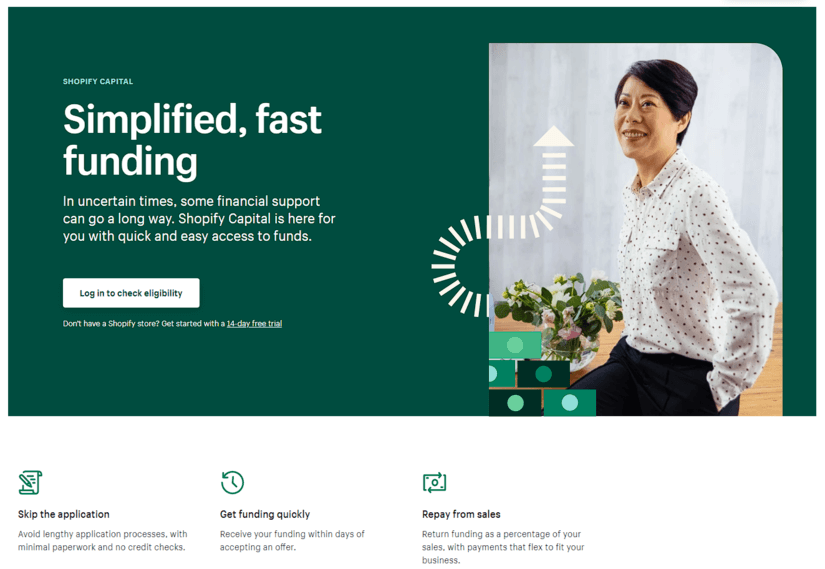
It is one of many funding sources available for the eCommerce owner. But this one is only available to anyone that owns a Shopify store by default.
How Does Shopify Capital Work?
Shopify Capital works like any lending program as a loan or cash advance would, but without interest. There is a set repayment percentage and borrower’s fee. Three pre-approved fund amounts based on your sales volume will be available. Repayment deductions are also based on your daily sales.
The funding options page is available on your Shopify admin screen. Here are the steps:
- From your Shopify admin, go to Settings > Capital.
- Find the eligibility message from Shopify Capital, and then click View funding offers.
- On the Capital page, you’ll see three funding options. Compare the terms of the funding options, and click Request beneath the one that you want.
- The terms of each option will include the amount received and the total owed. This also includes the daily repayment rate that gets deducted from your daily sales. This will be repaid to Shopify Capital.
- In the Review and accept terms dialog, carefully review the Terms and Conditions section, and then click Shopify Capital Agreement to open it in another browser tab.
- Carefully review the terms of the Shopify Capital Agreement. If you agree with the terms, then go back to the Review and accept terms dialog, and click Accept terms.
Shopify Capital Loan
The first available option is in the form of a lump-sum loan. This should be paid back at the end of 12 months. These are deducted from daily sales. Also, it should reach at least a sixth of the total amount owed every 60 days, which is called a milestone. In case the loan repayment is not reached per milestone, the deficit gets deducted from your bank account.
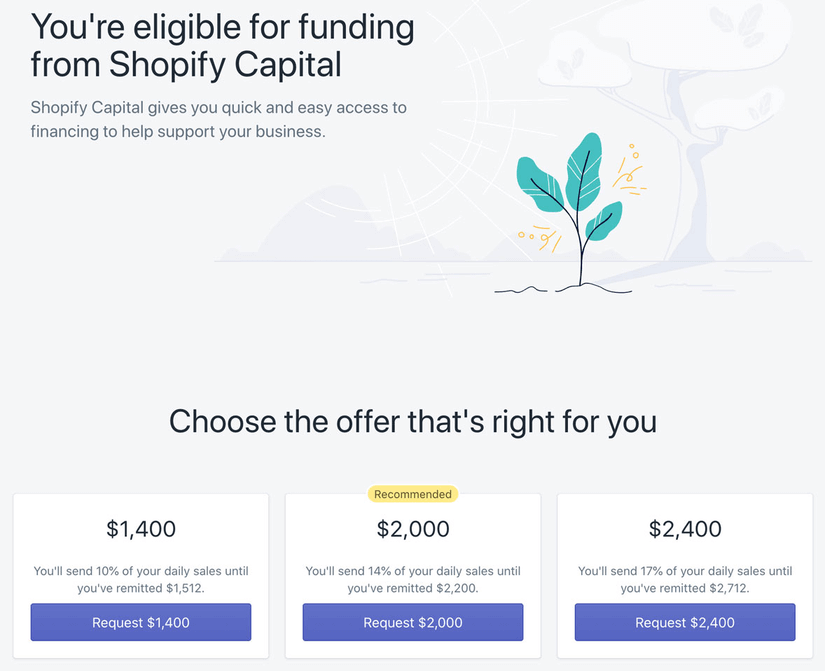
This is only available in select US states. See below if your current location applies.
- Arizona
- Idaho
- Illinois
- Indiana
- Iowa
- Kansas
- Louisiana
- Maine
- North Carolina
- South Carolina
- Utah
- Washington
- Wisconsin
- Wyoming
Shopify Capital Merchant Cash Advance
This is a more lenient version of the first lending option. Unlike the loan, it has no milestones. It also has no forced debit from your bank account should sales numbers not make it enough for the system to take. There is also no set deadline for repayment and will depend on your agreed future sales amount to pay towards Shopify Capital, which is the total to remit. This total is completed through a percentage of your daily sales remitted to Shopify Capital until it is complete. This daily sales revenue percentage taken by Shopify Capital is called the remittance rate. It is deducted automatically from the business bank account specified.
The remittance rate is still at 10%, the same as the loan. As it has no deadline though, it can take up to an unspecified amount to complete repayment. There is an option to remit the remaining balance in a single lump sum if you have remitted over 25% of your total to remit.
This option is available to the rest of the USA, the whole of Canada, and the UK.
How Do You Qualify for Shopify Capital?
For a Shopify store owner to be eligible for Shopify Capital, they should have the following criteria:
- Your store is located in the United States, Canada, or UK.
- Your business has a low-risk profile.
- Your store has Shopify Payments or another third-party payment provider enabled.
- Your store processes a certain amount of sales.
If you are eligible, you should receive an email invitation from Shopify. From there, you can view your pre-approved loan or merchant cash advance amounts. If you have not received anything, it means that you need to review your store. It may lack one of the requirements listed. Though the last criteria is a bit vague as there is no set amount disclosed to reach.
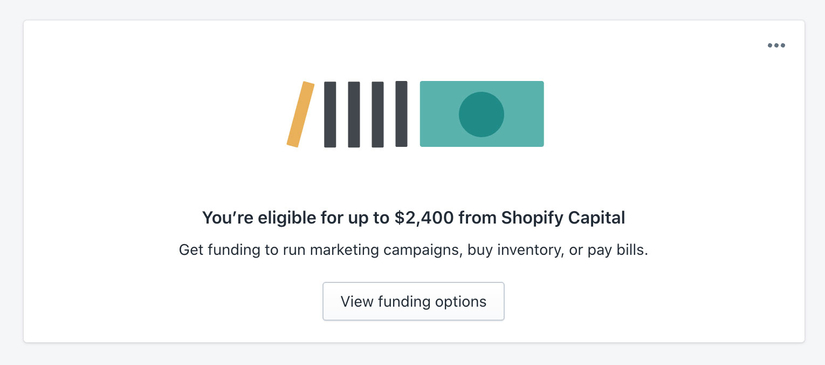
How Much Does Shopify Capital Give?
Both Shopify Capital Loans and merchant cash advances can provide from $200 to $1,000,000 in support for US-based sellers. Here are the following rates for the remaining locations.
- Canada - $200 to $500,000 CAD
- UK - £250 to £375,000 GBP
If you are eligible, Shopify Capital will provide you three pre-approved loan amounts. Each of them with a fixed borrowing cost and a 10% remittance rate.
To define, the remittance rate is the percentage of daily sales revenue being taken by Shopify Capital as repayment for the loan or cash advance. This remittance rate is then taken from the business bank account until such time that the total to remit is fully paid.
These amounts will depend on your actual sales numbers and your risk profile. Once approved, the funds will go straight to your bank account set on Shopify Payments. Once you have paid the loan amount in full, you can reapply should the need arise and with a much bigger loan amount.
How Can You Use the Funds From Shopify Capital?
So you have received the appropriate funding, now what? There is a lot that you can do with the money you have. You can focus on boosting marketing. That requires a separate budget that you need to pull funds from, especially ad spend. You can also use this to beef up your available inventory for reselling. Or you can expand your product scope if you’re looking beyond the present.
Now we will do a deep dive into what you can do with your newly acquired funding.
Procure more inventory
There are two facets of adding inventory in this situation.

If you are in the retail or wholesale business, you would look into restocking. You also might want to expand to a different niche of products. For this, you will need funds. Especially when sales are slow or you are lined up with unpaid invoices, this is an advantage. This secures continuous cash flow and/or will help with your future business growth.
If you are a grassroots seller with your own products as your merchandise, this will also help. It will increase your production by adding to raw materials or employing manpower. You may also use funding if you are looking towards location expansion, thus giving you a bigger market to chew on.
Increase Ad Spend
Shopify’s working capital can be used to bolster your marketing efforts.
Ad campaigns focus on using keywords and demographics data to showcase your business to people who might be interested in your products. Some keywords cost higher than the average per click - which is purported to be at $2.32 with Google Ads. The reason behind the keyword cost per click (CPC) is high is due to the competition.
A clear example would be a service-based industry. A lawyer that handles rare cases like accidental and vehicular insurance. Because it is an untapped market they can earn more for their services. This means they are willing to bid more for keywords, driving up the average CPC for those terms.
As we are focused more on the eCommerce realm, the market is fairly open. There are a wide variety of keywords you can target but many niches also have a lot of sellers competing for those keywords.
It is recommended by the U.S. Small Business Administration that a small percentage of your gross revenue should be spent on marketing and advertising. It does make sense given that you are promoting your business and the more money you spend, the more you should be able to get out of it in the end.
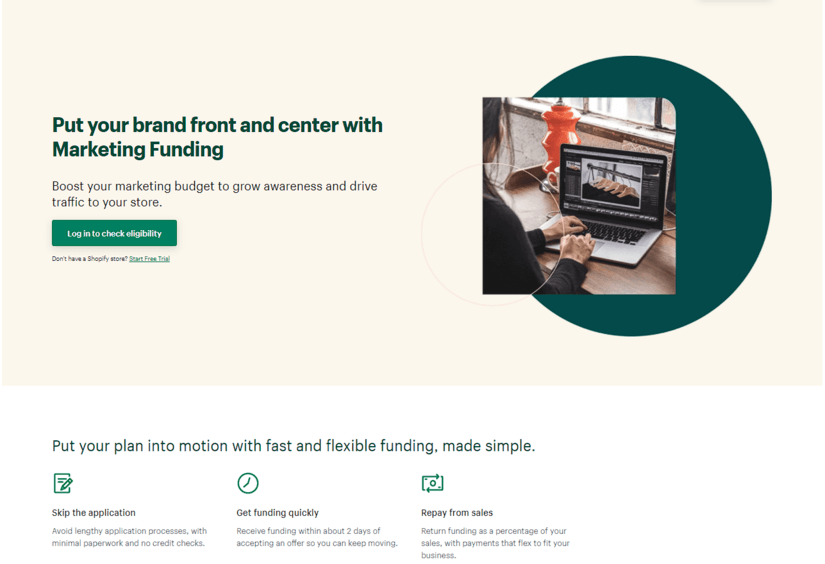
Running ad campaigns take time and money to maintain. If you think that your current ad campaign is not working for your business, you may need to re-evaluate your options and change marketing strategies.
Google Ads, Facebook Ads, and Instagram are the three most used online marketing solutions for SMBs out there.
eCommerce, as it is, has an average CPC of less than $1 in Google Ads. There are a variety of campaigns you can run including search, display, shopping, and video.
Facebook Ads is also an avenue for the business owner to take advantage of as it has lower CPCs across all industries. Retail, for one, only is at $0.70. This is the same with Instagram.
If your store reaches the average eCommerce conversion rate (2%) or higher, this might be an advantage. Say you have allotted $1,200 for your ad spend and you set the CPC to $1.
You’ll get at least 1,200 people to your store. With the average conversion rate, you will have 24 sales. If you have an average order value of $100, you will have $2,400 in revenue. Keep this up and you can double the money that you spend on ads.
Invest in a new project
Investing in new projects will take a toll on your budget. You already have the vision, all you need is the execution.
A project may be in the form of product research if you are selling your goods or services. This is something that can distinguish your business from the competition with something special or better.
It can also be a new business niche that you are interested to get into and would look at as lucrative.
These will require funds to cost, especially the last one where you’re most likely to start from scratch. Things like resources, tools, and possibly people and services to achieve your intended outcome are just part of what you need money for.
How Does Repayment Work?
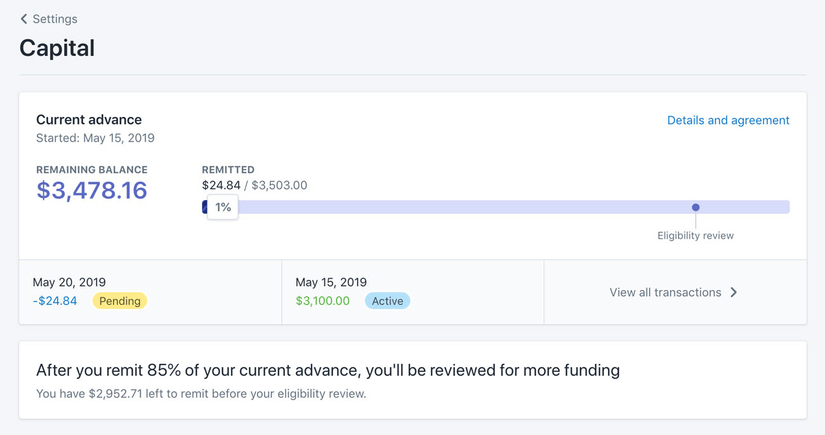
Shopify Capital, either through a loan or merchant cash advance, will take a percentage of your daily sales as repayment. The loan option is stricter as it needs to comply with a specific amount every 60 days and will debit from the bank account declared in Shopify Payments if it falls short. The merchant cash advance, on the other hand, will not take from you if you fail to generate sales on any given day.
There is also an option to pay for a specified lump-sum amount in advance or pay the rest for one-time, as long as it is over $20. Here are the steps below.
- From your Shopify admin, go to Settings > Capital.
- Click Make a payment.
- Choose the amount that you want to pay - a custom amount or the full remaining balance.
- Click Next step and review the amount to be repaid.
- Click Make a payment.
Remember that there is no penalty for the completion of repayments before the 12-month term ends for loans. With that said, this also bears no benefits other than finishing what you owe early.
You can also check and track your progress with repayments through the Shopify admin dashboard by going to Settings > Capital.
Does Shopify Capital Have Customer Service?
Shopify Capital does not have its specific customer service team, per se. Shopify support and the Shopify Capital help center fill that gap. Shopify support is available through live chat, email, and phone.
What Shopify Capital Alternatives Are There?

Aside from Shopify Capital, there are other funding sources available for Shopify store owners. Stripe Capital and Square Capital are payment merchant-based funding options for you to take advantage of. They work akin to Shopify Capital - they will review your eCommerce platform and provide funds on the same day as the application. They also require repayment through your daily sales revenue.
Fundbox is another alternative but this one requires a credit review and at least $50,000 in annual revenue.
Aside from the above, here are two of its most popular and notable competitors.
Shopify Capital vs Clearbanc
Clearbanc is a Canadian-based institution catering to online entrepreneurs to help with funding business needs through merchant cash advances. Like Shopify Capital, they also provide repayment through a certain percentage of sales depending on their sales trend. This means the higher the sales trend per month, the higher the annualized rate. They offer a minimum of $10K to $10M with a 6-12% payback fee on top of the principal. Clearbanc’s fee varies on what you will use the funds for, either ad spend, inventory, or something else entirely.
Clearbanc is also taking a greater risk with small businesses given their investments are higher than Shopify Capital’s, hence their criteria matching that degree of risk.
Here are their qualifiers for funding:
- average monthly revenue of at least $10K
- at least 6 months of consistent revenue history
- business must be incorporated (ie. corporations or limited liability companies) in North America or the United Kingdom
They also base their funding offers on the data being compiled from your sales and marketing accounts, which you can connect through Clearbanc’s dashboard. Your Sales Account should be your main eCommerce store and Google Ads for marketing. Once approved, funding will be made available via a virtual VISA card or their VendorPay platform.
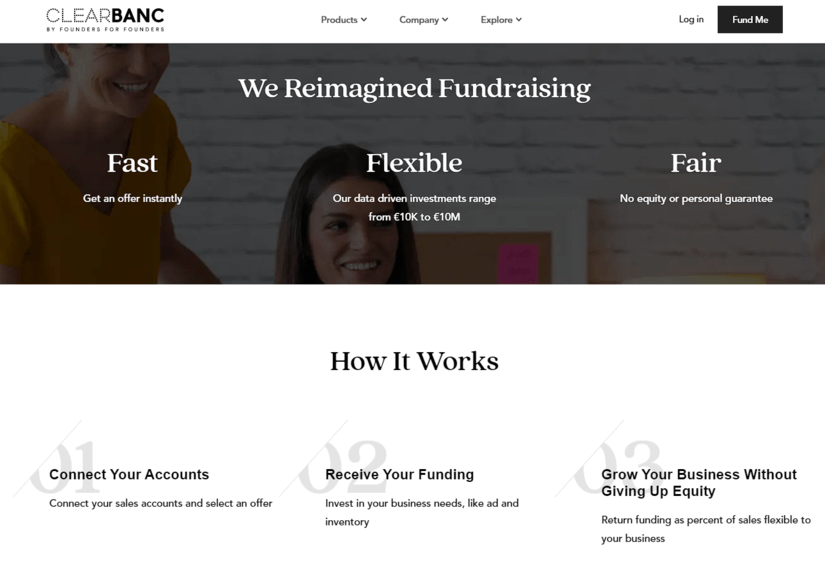
Their turnaround from funding requisition to receiving the funds is 3-5 days. It may take longer if the amount requested is higher than usual.
Shopify Capital’s advantage over Clearbanc is its friendliness towards small businesses. On days when there are no sales, Clearbanc would still debit from your bank account when Shopify Capital will just leave you alone. Shopify Capital also lets you decide on the terms with Merchant Cash Advances while Clearbanc has a set 12-month term for repayment. On top of that, you need to be incorporated to apply for Clearbanc’s cash advance, which some small businesses are not.
About customer service, they have no outright and clear customer service availability other than the contact information provided on the footer of their website with social media links.
Clearbanc is not limited to Shopify as it is also available in Amazon and BigCommerce, which is an advantage in terms of a wider scope. They also can connect to multiple sales platforms, which is great if you have a store other than Shopify.
Payability vs Shopify Capital
Payability is another source of funding for the eCommerce store owner. This also works the same way as Shopify Capital regarding merchant cash advances - they are based on future revenues and are lenient as well. If your sales are minimal for the day, the repayment is lower and vice versa.
There are 2 funding options for Payability that are ready to avail.
- Instant Access - this is a way of advancing received payments supposedly from unpaid invoices at least up to 80% of sales revenue from the previous day. It is to secure cash flow and prevent delays where you may need the money elsewhere. There is a fixed fee of 1-2% on top of the principal. You will need to have at least 3 months of sales history and a $2k monthly sales figure to be eligible.
- Instant Advance - this practically applies the same as a merchant cash advance. There is a weekly fee starting at 0.75% of the total purchased receivables on top of the principal. Unlike Shopify Capital, you have a limited time to repay the total amount owed, which is 16-20 weeks. Do note that your advanced amount is up to $250,000 only, which is smaller compared to the other alternatives. For eligibility, Payability requires you to have at least 9 months of sales history and a $10k monthly sales average.

Payability also has wider support for marketplaces other than Shopify and Amazon like Walmart, Etsy, BigCommerce, and more. Like Clearbanc, there is also the option to connect to multiple marketplaces at once.
With its small funding cap, it takes faster to process applications up to 24 hours. Funds are received either through the declared bank account or their Seller Card which is affiliated with Visa.
Credit checks? No worries! Same as Clearbanc and Shopify Capital, there is none.
The eligibility process will also require the borrower to connect their platforms just like with Clearbanc, albeit at a much quicker pace for review.
Their customer service is also easily available via phone and email support with their working hours at EST (Monday to Friday, 9 am to 6 pm).
In comparison to Shopify Capital, funding applications are easier and faster just because there are lower borrowing amounts involved. It is recommended to be an additional funding source on top of Shopify Capital instead of an actual alternative, should the need arise.
There’s also the lucrative rebate system for those who pay early. The remaining weeks left correspond to a rebate for fees that were supposedly due.

Should I Borrow Money for My Ecommerce Business?
When it comes to the question of borrowing money to fund your business, the answers are mixed. But often, either answer makes sense.
If you don’t borrow money, you run a risk of losing your own money and time that you put in your business should it fail to gain any traction.
But, you don’t have to worry about paying any debts from debtors since you did not borrow in the first place. Also, anything you earn will help fund other aspects of the business or give you a reservoir for other ventures and expansions.
If you go to a bank to borrow money, it will take a while to earn income as much of the proceeds will go to interest payments. Some institutions will be more lenient than others with rates and payment terms that will work to your advantage. The only boon here is borrowing saves you from using your reserves.
On the other hand, borrowing money can be an effective source of funds for growing an already successful business. With extra funds, you can boost up your budgets like marketing.
If you are already getting a positive return on investment with marketing, adding more money to your ad spend can help you scale your growth faster.
In the end, the decision is with the business owner. It depends on their current financial standing and means to be able to pay.
Key Takeaways
Among the available avenues for funding, Shopify Capital is the most balanced one of the bunch. They have a reasonable wait time, lenient repayment schemes, and a wider scope of amounts available to borrow.
This makes Shopify Capital an easy-to-acquire and well-thought funding source for Shopify sellers. In the current situation with the pandemic and limited ways to self-fund your business from other means, avenues like Shopify Capital go a long way to help.
Shopify Capital Pros
- Available within Shopify by default
- Provides sales revenue-based repayment scheme
- Easy to apply for
- Transparency with repayment progress
- Approval is fast
Shopify Capital Cons
- Only available within Shopify
- Daily repayments
- Sales requirement is unclear for eligibility



